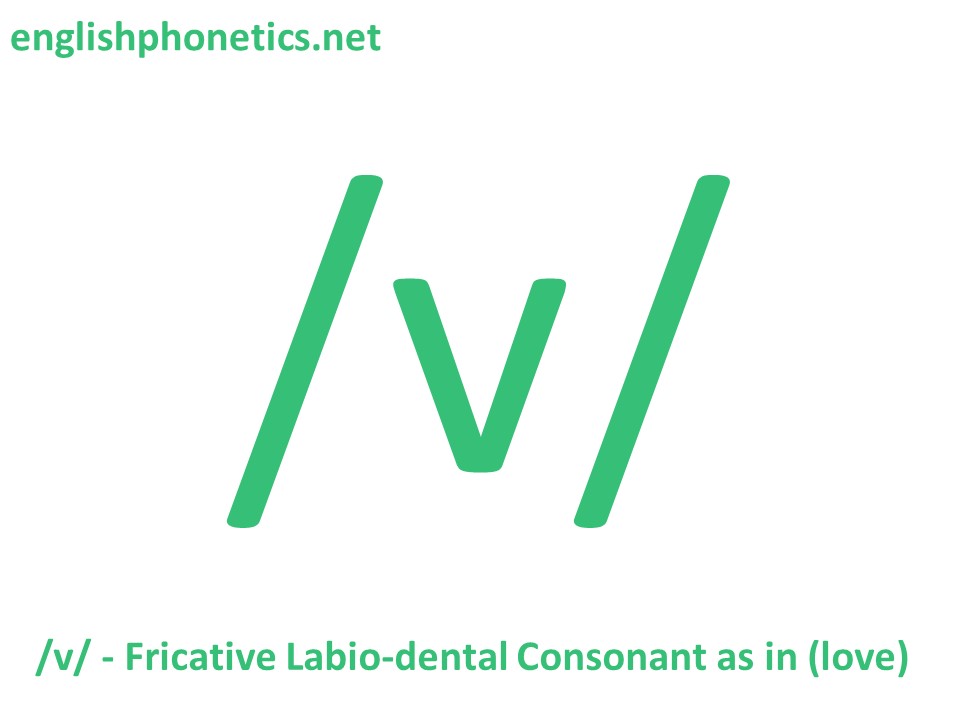Spelling:
- “v”/”ve” – vet, leave
- “f” - of
LISTEN
The sound /v/ can be in these consonant clusters
-
Beginning of a Syllable
(none)
-
End of a Syllable
| v_final_clusters.mp3 |
/lv/ (“lve”)
-
shelve
/lvz/ (“lves”) - themselves
/lvd/ ("lved") - delved
/rv/ (“rve”) - carve
/rvz/ (“rves”) - serves
/rvd/ ("rved") - starved
/lvz/ (“lves”) - themselves
/lvd/ ("lved") - delved
/rv/ (“rve”) - carve
/rvz/ (“rves”) - serves
/rvd/ ("rved") - starved
Grammar Tip:
The sound /v/ is present in the suffix “-ive.” This suffix may turn a verb into an adjective, or sometimes a noun.
| grammar_-v-.mp3 |
- act --> active (adjective)
- create --> creative (adjective)
- decide --> decisive (adjective)
- direct --> directive (noun)
COMPARE
Compare /v/ with /f/:
| compare_v-f_1.mp3 |
/v/…/f/…/v/…/f/…/v/…/f/...
Both /v/ and /f/ are labiodental, fricative consonants. However, /v/ is voiced and /f/ is voiceless. When you pronounce /v/, your vocal cords should vibrate. At the end of a word, the vowel before /v/ will be longer than the vowel before /f/.
Both /v/ and /f/ are labiodental, fricative consonants. However, /v/ is voiced and /f/ is voiceless. When you pronounce /v/, your vocal cords should vibrate. At the end of a word, the vowel before /v/ will be longer than the vowel before /f/.
You can hear the difference between /v/ and /f/ in these words.
| compare_v-f_words.mp3 |
1. A. vine, B. fine
2. A. veer, B. fear
3. A. view, B. few
4. A. save, B. safe
5. A. proves, B. proofs
6. A. believe, B. belief
2. A. veer, B. fear
3. A. view, B. few
4. A. save, B. safe
5. A. proves, B. proofs
6. A. believe, B. belief
Now, compare /v/ with /w/:
| compare_v-w_1.mp3 |
/v/…/w/…/v/…/w/…/v/…/w/…
Both /v/ and /w/ are voiced consonants that involve lip movement. However, /v/ is a voiced labiodental consonant, and /w/ is a bilabial glide. When you pronounce /v/, your upper lip should rub against your lower teeth, but when you pronounce /v/ your lips should not touch your teeth.
Both /v/ and /w/ are voiced consonants that involve lip movement. However, /v/ is a voiced labiodental consonant, and /w/ is a bilabial glide. When you pronounce /v/, your upper lip should rub against your lower teeth, but when you pronounce /v/ your lips should not touch your teeth.
You can hear the difference between /v/ and /f/ in these words.
| compare_v-w__words.mp3 |
1. A. vest, B. west
2. A. vow, B. wow
3. A. vale, B. whale
4. A. viper, B. wiper
5. A. verse, B. worse
5. A. roving, B. rowing
2. A. vow, B. wow
3. A. vale, B. whale
4. A. viper, B. wiper
5. A. verse, B. worse
5. A. roving, B. rowing
PRACTICE
Listen and repeat these words:
| words_with_-v-.mp3 |
|
1. vest
2. very 3. veer 4. violin 5. visor 6. vendor 7. love 8. save 9. shelve 10. curve |
11. above
12. believe 13. creative 14. over 15. heaven 16. moving 17. deliver 18. advice 19. convey 20. advantage |
Now, practice /v/ in sentences. Say the words first, then the sentences.
| sentences_with_-v-.mp3 |
1. travel –
overseas – vacation
We will travel overseas on our vacation.
2. five – visitors – arrive
At five o’clock, our visitors will arrive.
3. vendor– seventh - souvenirs
The vendor on Seventh Street sells souvenirs.
4. of – relatives – love – volleyball
All of our relatives love volleyball.
5. approve – of - violent - behavior
I don’t approve of his violent behavior.
6. every – evening – drive – visit
Every evening, I drive to visit my grandfather.
We will travel overseas on our vacation.
2. five – visitors – arrive
At five o’clock, our visitors will arrive.
3. vendor– seventh - souvenirs
The vendor on Seventh Street sells souvenirs.
4. of – relatives – love – volleyball
All of our relatives love volleyball.
5. approve – of - violent - behavior
I don’t approve of his violent behavior.
6. every – evening – drive – visit
Every evening, I drive to visit my grandfather.
To practice with different varieties of English, choose another native English speaker by clicking one of the links below:


